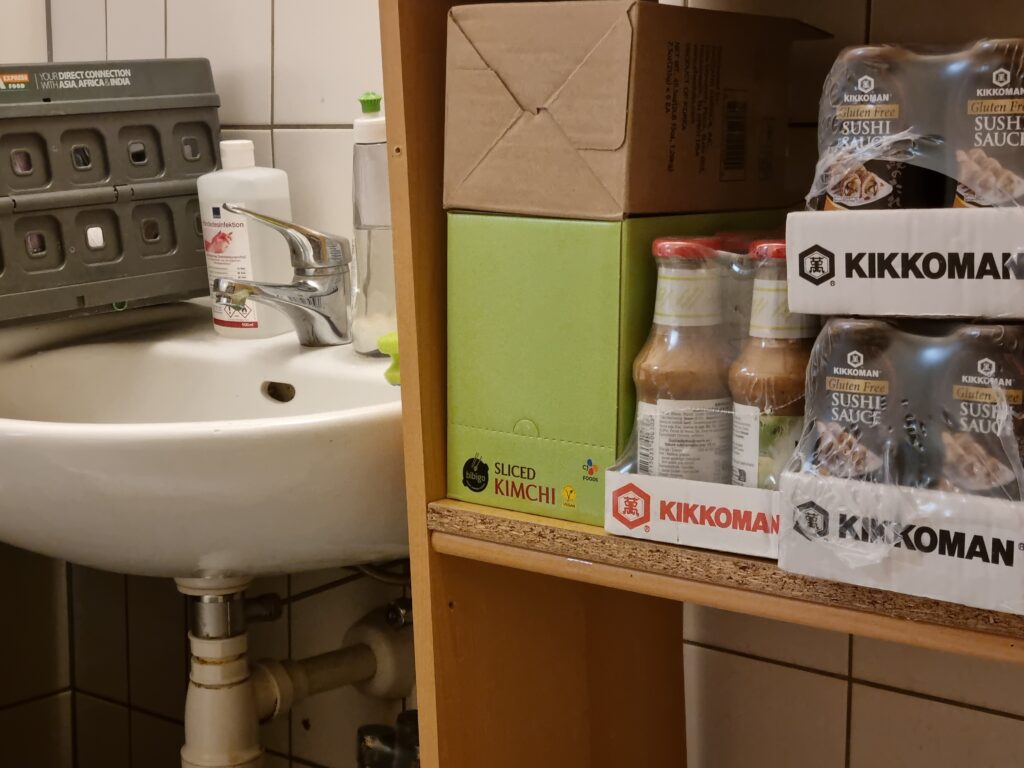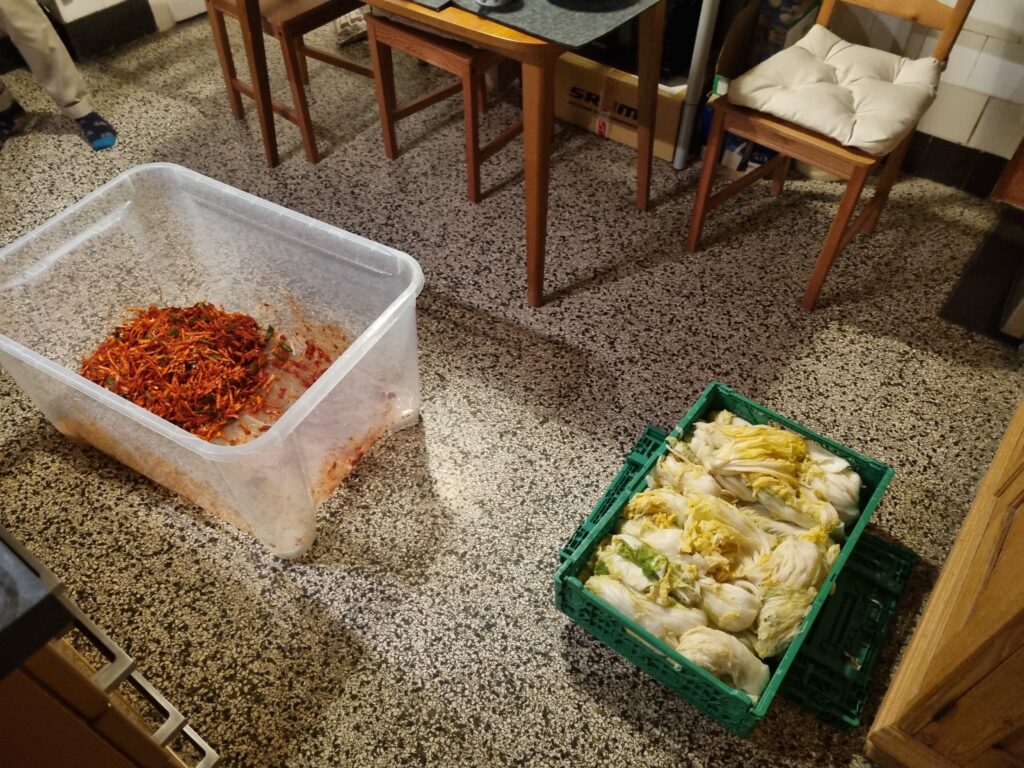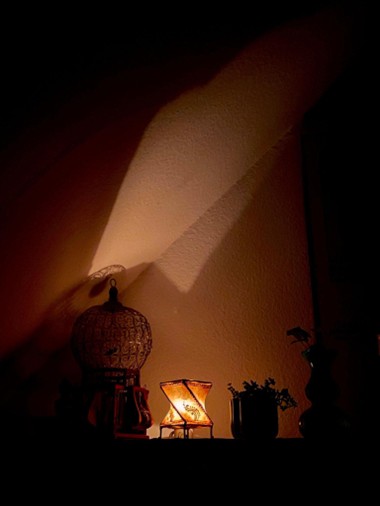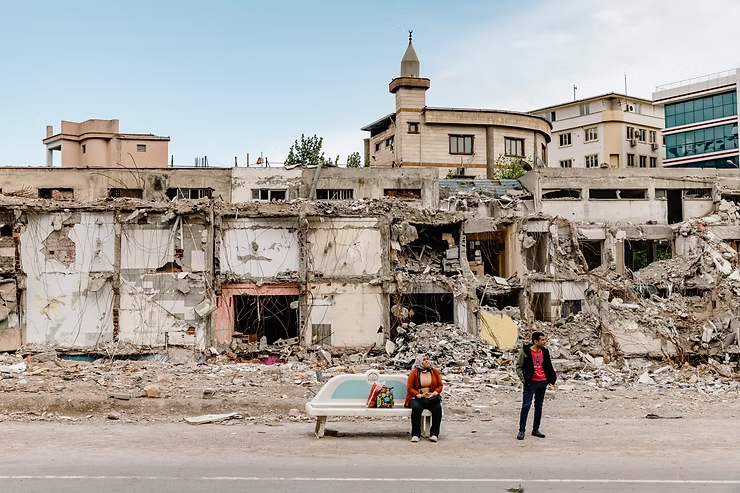While preparing to move from my tiny, shared 9-square-meter room to a significantly larger apartment to live with my boyfriend, I was confronted once again with two large white plastic boxes I had nearly forgotten in the cellar. They were filled with the most random assortment of dried vegetables, grains, and flours—ingredients I had hoarded over at least five years during trips to Korea and visits to Asian supermarkets across Germany. The containers had been shoved into a corner of the basement, and I’d never had the chance to go through them during the rush of previous moves. I decided not to sort them in the cramped space I was leaving but to wait until I arrived in the new, more spacious apartment.

After the move, which took nearly two weeks, I finally unpacked and began sorting through the contents. Many of the powders, like mung bean starch or dried gondeure (dried thistle), had expired. I asked friends and my boyfriend whether I should throw them away. Their consensus was, “It’s fine. Those things don’t really go bad.” So I kept them, hoping they’d find their way into something, someday.
With a friend visiting from Lausanne—someone I’d worked with at a Vietnamese restaurant in Mainz—I felt motivated to make kimchi. I trusted her knife skills and knew she wouldn’t be overwhelmed by the sheer amount of garlic we’d peel or the precision required to julienne carrots and daikon radish. Occasionally, she’d give me 10 kilograms of kimchi whenever I visited her, especially once she discovered I had none in my refrigerator. I remembered the 1kg packet of gochugaru (Korean chili powder) buried in the pile of things I couldn’t bring myself to discard. I suggested we make kimchi as our weekend project in Heidelberg. That’s all we needed: garlic, gochugaru, sticky rice powder, apples, pears, onions, a lot of salt, fish sauce, and napa (Chinese) cabbage.
It was late November, when the winds had grown cool and heavy cabbages appeared neatly stacked in supermarkets and markets. Not to question their presence, but I always wonder who in Germany cooks with that much cabbage—and for what? For me, the purpose was obvious. I’d haul back around ten of them, hoping each weighed at least two kilograms. Cabbages are harvested earlier in Germany than in Korea, and I used to be surprised by their smaller size. I’d grown up with ones that weighed five or six kilograms. Now I was simply glad if they weren’t hollow or dried in the middle, and weighed more than 1.8 kilograms. In Korean, we call sturdy, full vegetables like these silhada (실하다). Seeing one at the right time of year would immediately make me think of kimchi. But in Germany, I’d never seen a silhan (실한) cabbage. A woman from the Korean-German Christian community once told me you have to ask local farmers to harvest them late if you want cabbage suitable for Korean standards.
The night before we began, we salted 20 kilograms of cabbage in a large plastic container placed over the bathtub. By morning, the cabbages had released much of their water and shrunk. We made the filling—called “sok (속)” in Korean, which translates to “the inside”—by mixing sticky rice powder with water, then adding pureed onion, apple, pear, and shrimp paste. When I opened the gochugaru packet to mix it in, I discovered that the chili powder had hardened and was covered in white mold. It was Sunday, and the only Korean acquaintance I could message in Heidelberg wasn’t home. We didn’t know what to do.
Coincidentally, I was set to start a job at the local Asian supermarket the next day. My friend suggested I just pick up 2 kg of fresh chili powder after work, and we’d finish the batch then. There was no other option. Still, we enjoyed the salted cabbage leaves with suyuk (boiled pork belly) and raw garlic—something we rarely let ourselves indulge in, knowing how the garlic smell would linger for days.
There are moments of doubt I carry with me, especially around smell. It might be a kind of habitual obsession that makes me worry about how I smell to other people. Living in Heidelberg among international friends—and in the wake of COVID-era stories of heightened anti-Asian racism—I’ve come to recognize that smell can be racialized. I spent part of middle school in Texas, where racist comments were common, and I didn’t yet have the vocabulary to respond. I recall the confusing embarrassment of offering kimchi to classmates, only to watch them recoil in overacted teenage disgust. Friends in Heidelberg often told me not to overthink it. Still, in the thrill of being halfway done with our kimchi—kimjang (김장), the process of making kimchi—I let myself eat as much garlic as I wanted. Before bed, my boyfriend, who’s not at all sensitive to the smell, told me I was “fuming with garlic.”
On my first day at the supermarket, I assumed people would be more forgiving—after all, it was an Asian grocery. But even there, I was met with comments. A former Thai chef colleague told me he couldn’t stand next to me. Another colleague tried to reassure me, but, standing two meters away, still asked, “What did you do that you smell so much like garlic?” I told them I had made kimchi the day before. And so I became, instantly, the Korean girl who makes kimchi—and reeks of garlic—on her first day of work.
Kimchi came up often in dialogues at the store. One colleague, who turned out to be a picky eater, told me she couldn’t stand the taste or smell of it. Yet one of her regular duties was to pierce expanded kimchi bags—on the verge of exploding from fermentation—and reseal them. Every time she did, she’d squeal, rush to open all the doors, and complain loudly. I understood the reaction, but still, it stung. I felt embarrassed, as if I were the kimchi.
Answering questions about kimchi also became part of the job. It was surprising how much shelf space it took—entire aisles of jars, cans, and refrigerated sections. Over the four months I worked there, I developed a repertoire of responses. The most common question was about spiciness. The first time, a young boy asked how spicy it was. I reflexively said, “Spice is relative. So I don’t know how spicy it could be for you.” I regretted my snappy answer to such simple curiosity coming from a child. Over time, I realized that within the setting of an Asian supermarket, I was positioned not as someone being interrogated, but as someone expected to answer. These weren’t naive or racially charged questions—they were just questions. Sometimes, yes, drunk men would make inappropriate comments. But more often, it was genuine interest.
It was strange to confront how popular kimchi had become, elevated by social media to the status of a superfood. Some customers were looking to boost their probiotic intake. I eventually decided I was fine taking the time to explain what it is. After all, I was being paid to do so. But it’s not easy: describing the spice level, the consistency, the cultural meaning of a food that, for me, is simply everyday. Maybe answering those questions with such repetition required a level of dissociation, where it became easier as I gathered a larger pool of automated answers based on what people expected to hear.
That tactic of dissociation became useless when I was occasionally struck by the on-and-off grief of losing my grandma, who had passed away in the summer. I would sit down in the small office/storage room to eat my lunch and see 30g kimchi packages stacked on top of each other. It looked like a graveyard of kimchi, bereft of its soul. One day, answering questions based on cultural curiosity became especially hard when suddenly my phone was ringing with messages from friends in Korea. On December 3rd, 2024, I panicked upon hearing the news that the (now former) president Yoon had declared martial law. I quietly called three friends to ask what was going on—whether there was a war, or if this was the beginning of a dictatorship. Ridden with anxiety that I might not be able to see my friends or family again, I told my co-worker, “The president just declared martial law.” His response: “What? Keep working.”
That entire day, while the military rushed into parliament and my friends kept each other updated, I tried my best to just stay in the store and act like I was working. By the evening, it had concluded that the worst-case scenario could be stopped. When the store owner stopped by to drop off boxes, I told him what had happened. He replied, “Oh, these things happen all the time in those kinds of countries.”
I don’t know what kind of response I was expecting. Sometimes it feels like people practice certain reactions so often that when they’re faced with something unfamiliar, their response comes off as ignorant, unempathetic, or simply uncaring. I still don’t know what to make of these reactions, except to say that some emotions are not shared, perhaps because of cultural prejudice. Maybe these kinds of unsympathetic responses are also rehearsed and accepted elsewhere, but I can only guess.

About three months after our kimjang, my neighbor from across the courtyard introduced himself. He asked what I did—and quickly followed up: “Did you make kimchi a few months ago?” He said he’d like to try it, but all he had to offer in return was bolognese.
It still surprises me how many interactions leave me unsure of how to respond. I left that conversation with a chuckle, feeling both watched and uncomfortable, suddenly highly visible—called out for doing something unusual in Germany. Eating what I eat, making food for myself while worrying about the smell—these have become part of a routine I hardly notice anymore. I’m trying to unlearn these quietly depressing habits. I feel disappointed in myself for having assimilated too much, for not holding on to what I needed to protect in order to be myself. Relearning how to trust what my senses tell me to eat, smell, and feel is part of the process of trying to feel safe—and at home—in this country, where I’ve now lived for nine years.













